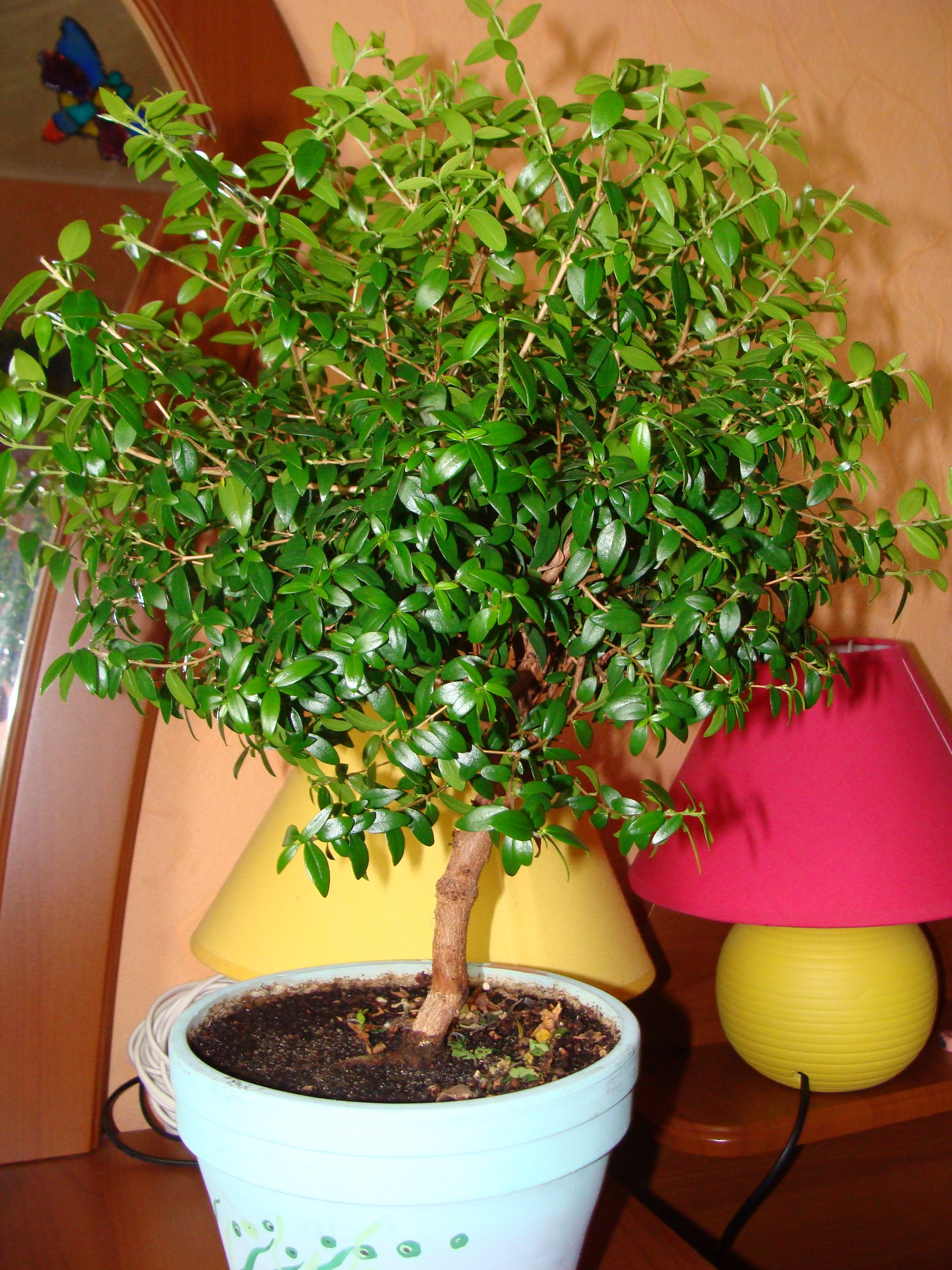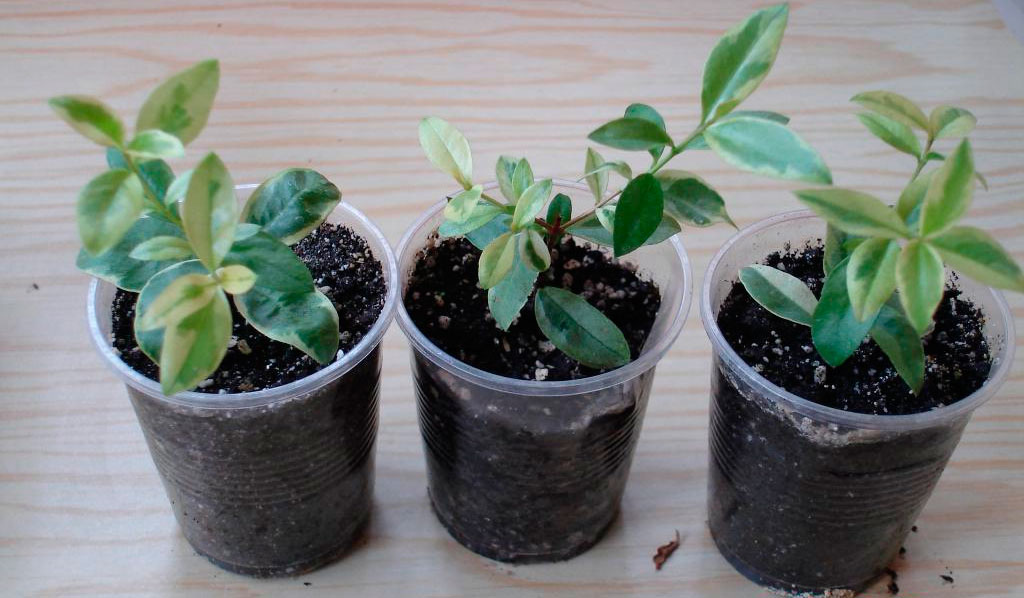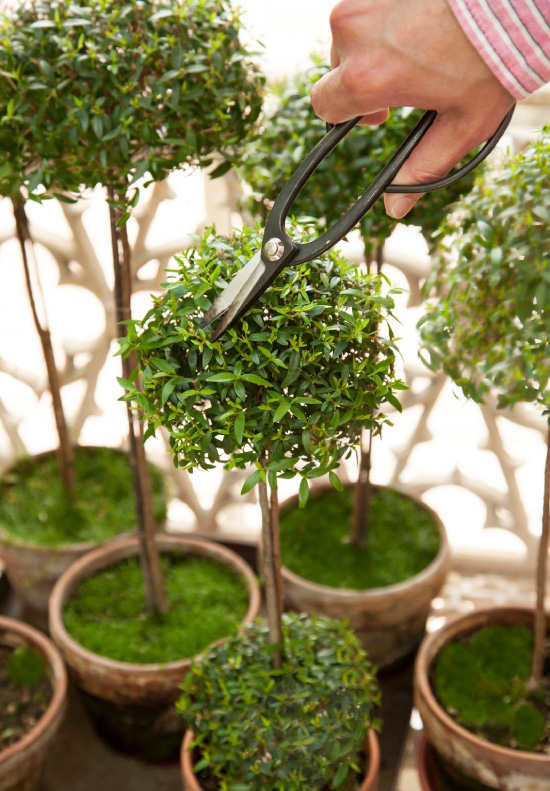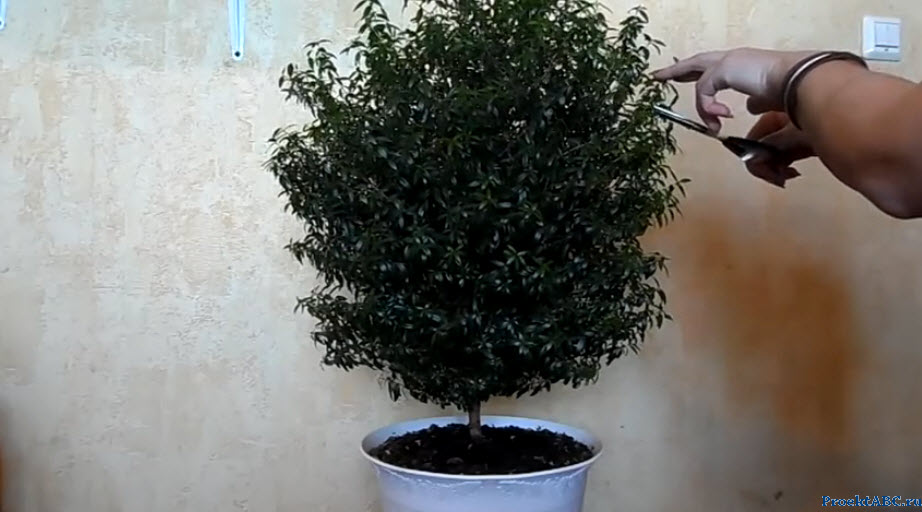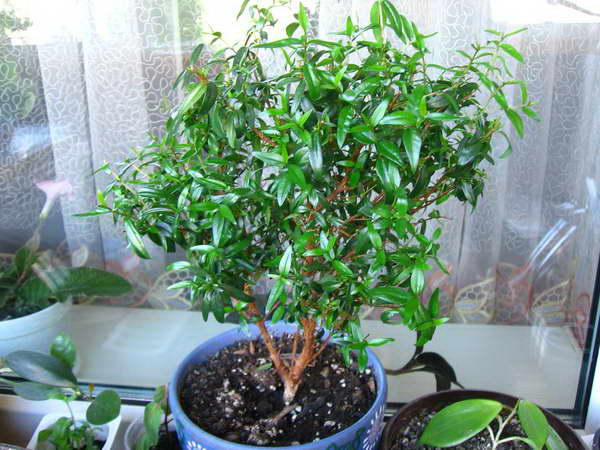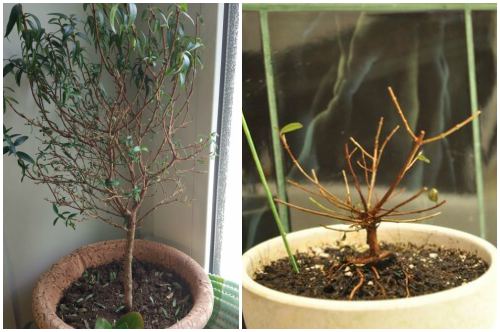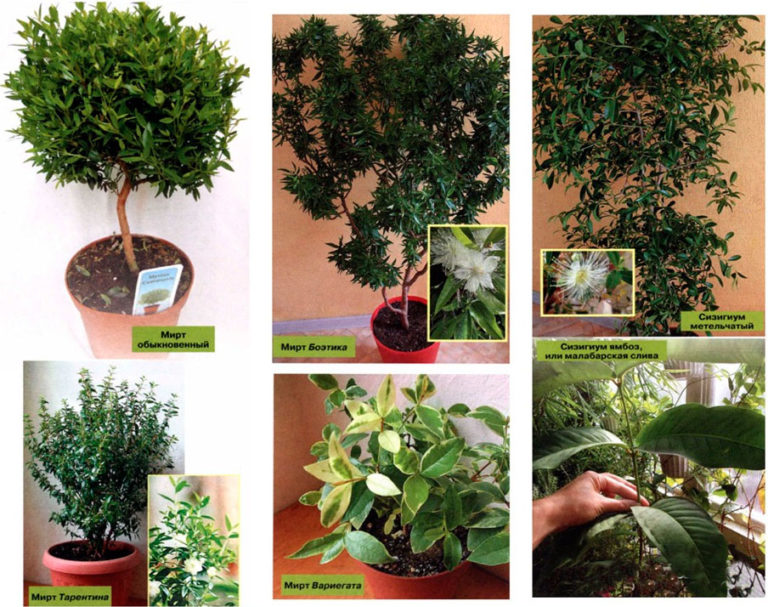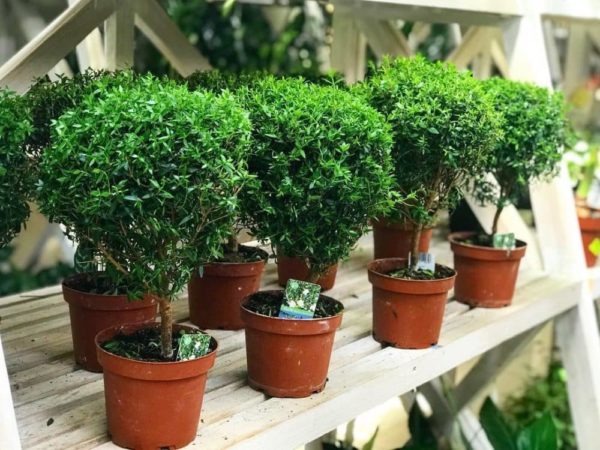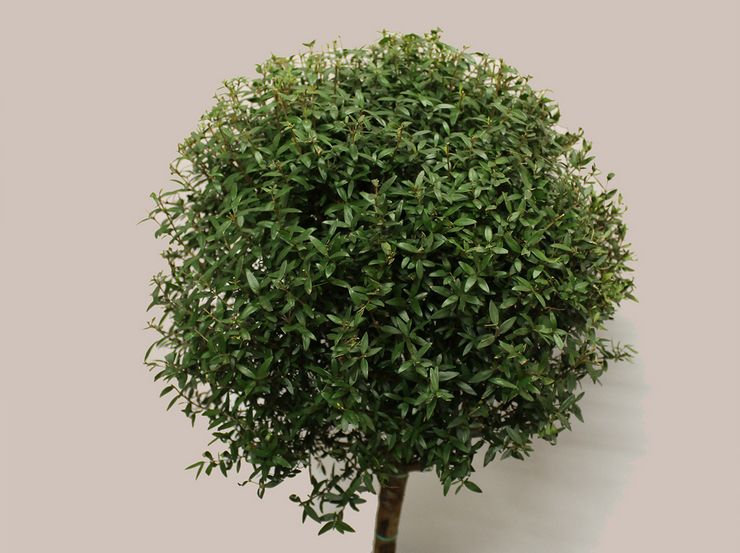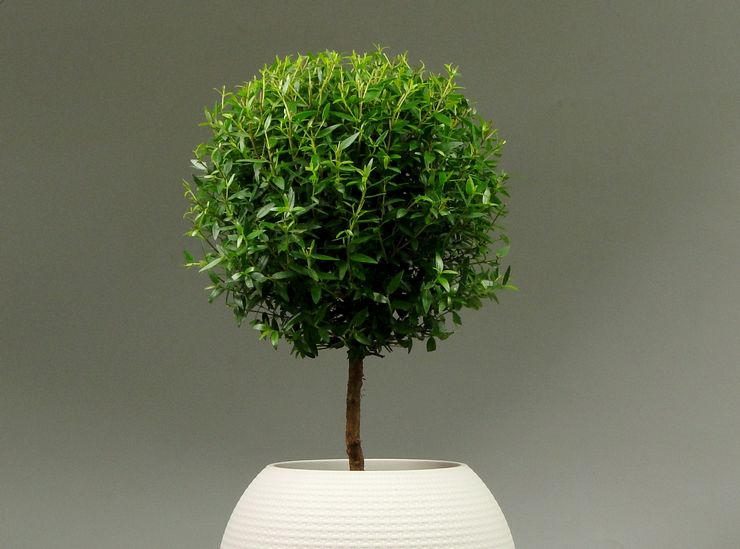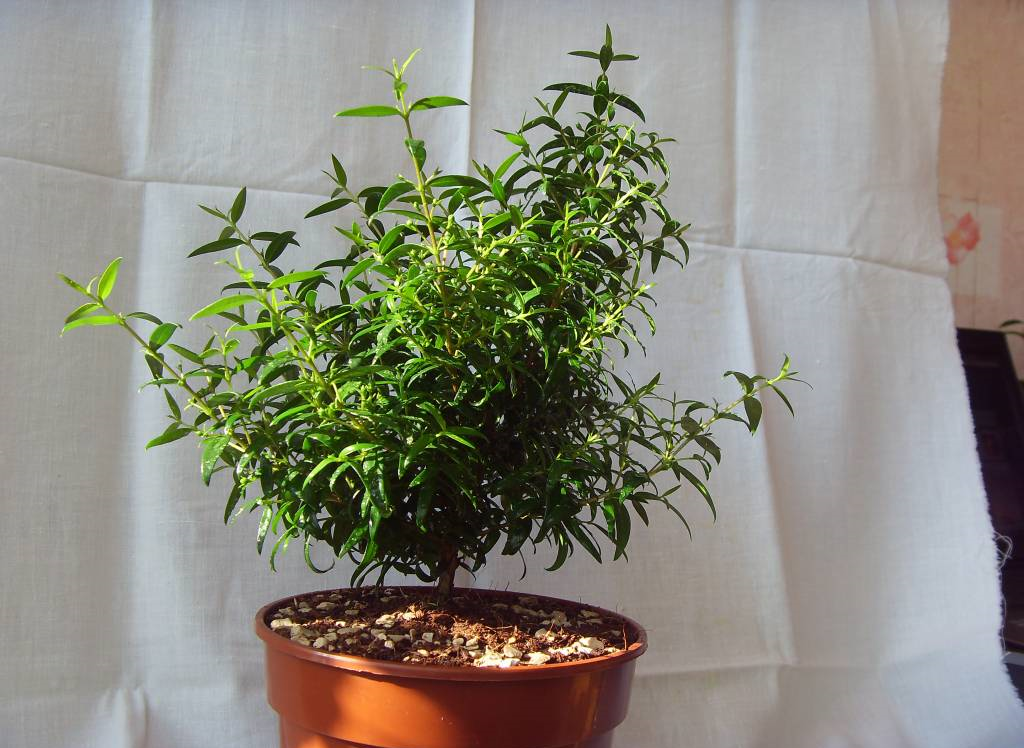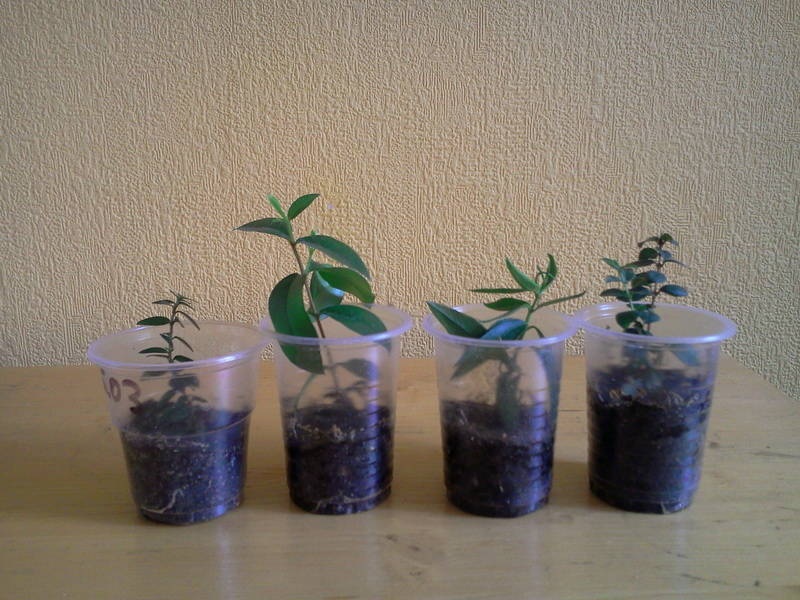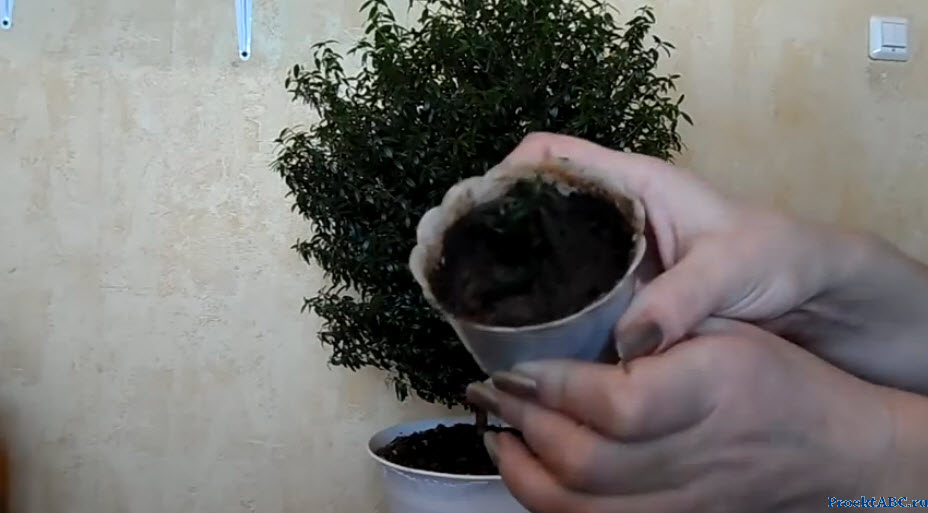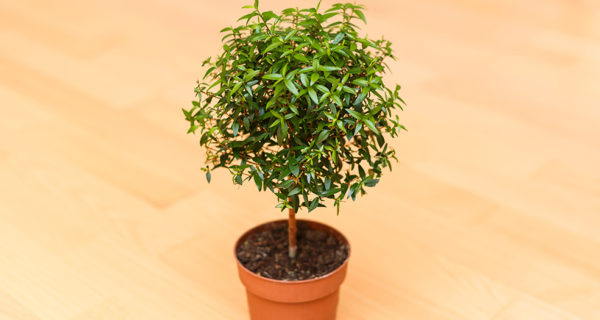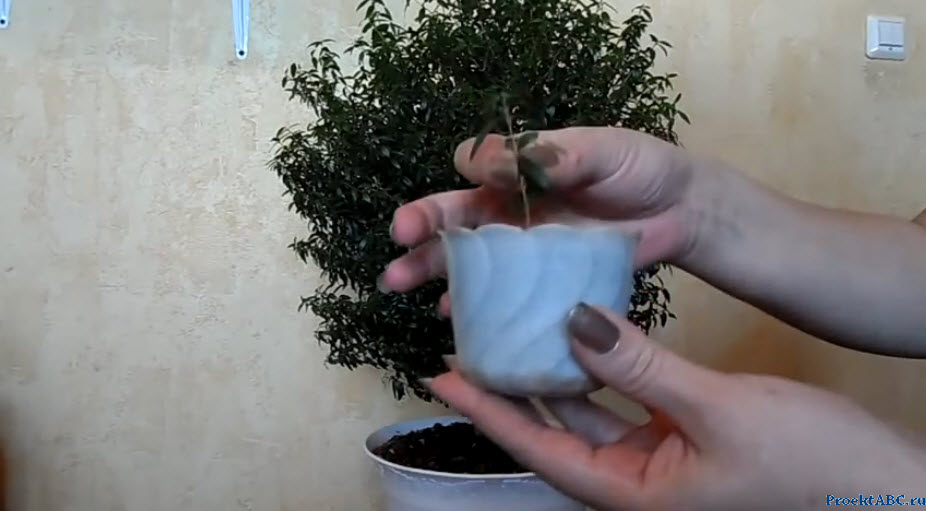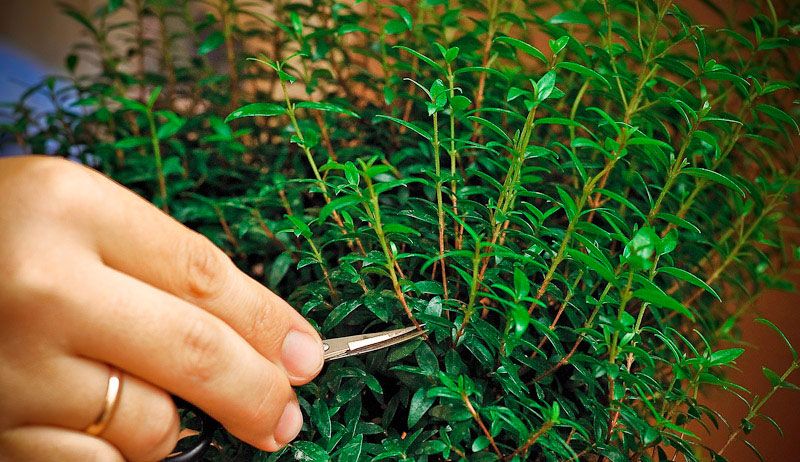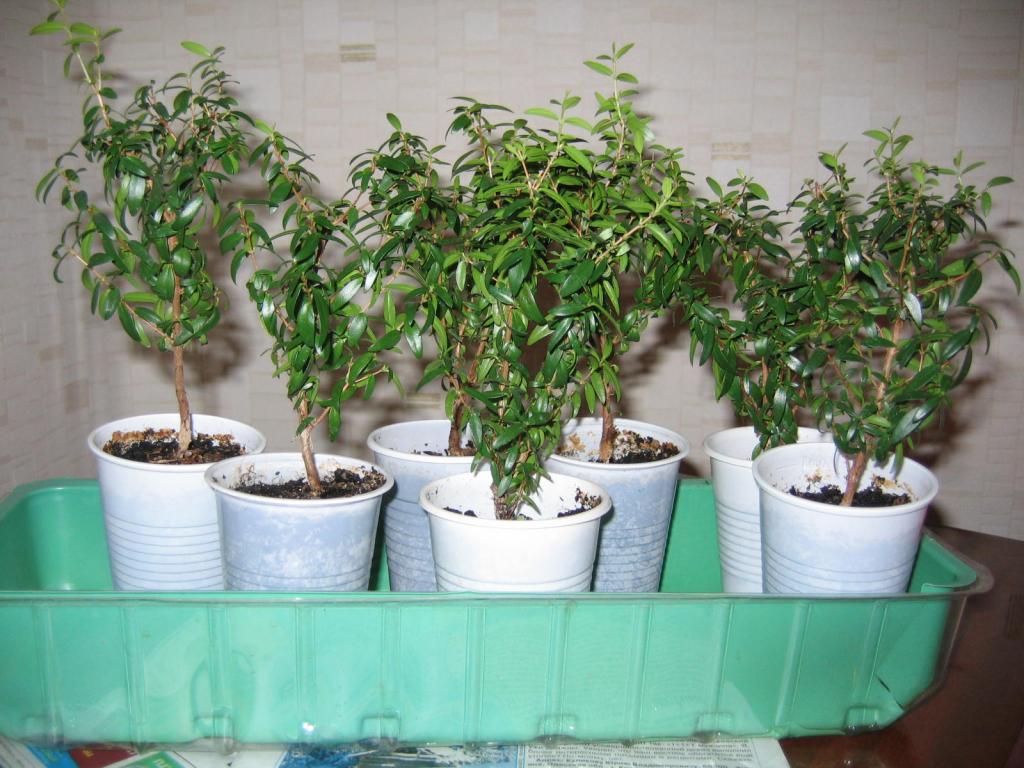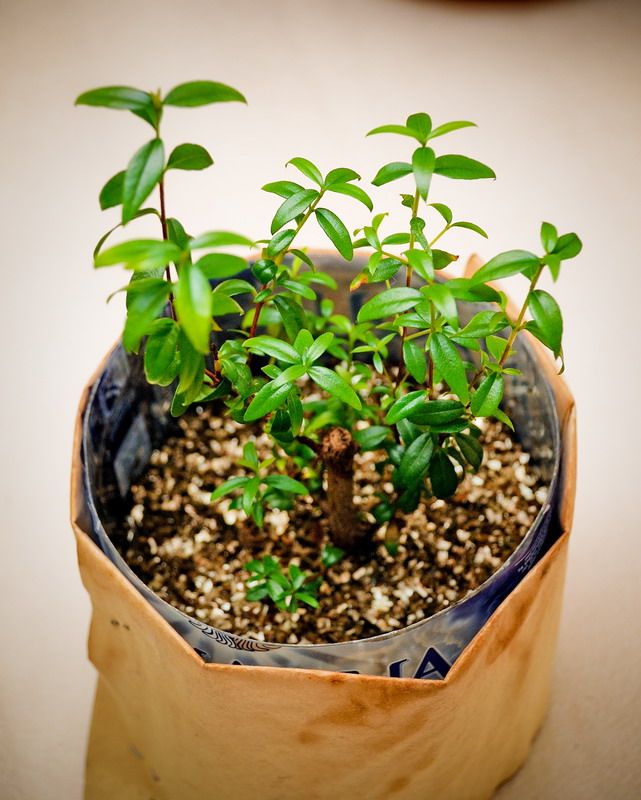Common myrtle: rules for caring for a houseplant
Home myrtle is a plant that is not too whimsical and ordinary, standard care allows you to get a healthy and highly decorative plant that will delight the grower for many years.
Temperature and lighting
The culture prefers bright and diffused lighting, but it can easily tolerate direct sunlight for not too long time. In winter, the myrtle should be placed in the most illuminated areas of the room. In the summer, the plant can be taken outdoors with protection from prolonged exposure to the direct midday sun.
Cultivation is carried out in moderate air temperatures, at 18-20 ° C in summer and about 6-8 ° C in winter. Only the right temperature readings and sufficient lighting allow for abundant and long-lasting flowering. In warm and too dry rooms, foliage can fall off massively from a perennial.
Watering and feeding
In the spring and summer, it is recommended to periodically spray the perennial with warm and well-settled water. Irrigation activities must be regular and abundant. Overdrying the soil coma provokes foliage to fall, but it is also impossible to allow stagnation of water after irrigation in trays.
In winter, as well as in late autumn, the aerial part of the plant does not need to be sprayed, and irrigation activities should be reduced to once a month. At this time, the decorative perennial does not need feeding at all.

Crown formation
Proper care of myrtle requires timely and competent crown formation. Many amateur flower growers prune the aerial part of the perennial in order to obtain an attractive form of a standard plant with a neat and fairly compact crown.
Common myrtle is characterized by a fairly rapid growth and is able to easily recover even after strong pruning. Nevertheless, one should not get carried away with such crown formation, since in this case the flowering of the perennial becomes less abundant and prolonged. In any case, the formation takes place in early spring or immediately after flowering.

Choosing a flowerpot and soil
When choosing a flower pot or flowerpot, it is recommended to give preference to sufficiently high and wide plastic planting containers, which allows the root system to feel comfortable and develop well. However, a too voluminous flowerpot provokes stagnation of moisture and is unsuitable for growing indoor myrtle. When cultivating in indoor floriculture conditions, it is best to use a planting soil consisting of sod land, medium-grained river sand and high-quality humus, mixed in equal proportions.

Myrtle flower home care and application
It should be noted that the myrtle tree extends its functions widely beyond the life of a simple house flower. Its components have been used since ancient times in culinary experiments, and for treatment and cosmetology, its use has been widely used.
In medicine
Myrtle oil is used in medicine about cosmetology
- What to say about the medical and cosmetology direction? In ancient times, noble and wealthy residents washed their faces with an infusion of the leaves of the myrtle tree, since it was believed that this procedure prolongs youth and beauty, gives freshness and lightness.
- Drinks infused with fruits were used as health and invigorating elixirs. Since the flower contains essential oils, it is appreciated by both traditional and official medicine.
- Phytoncides secreted by myrtle help to cope with colds, it has been scientifically proven that a plant just standing in a room kills many pathogenic bacteria, even a diphtheria bacillus and a dangerous Koch's bacillus, which causes tuberculosis, and this is good because there is no need to cripple the tree by cutting off the leaves. after all, myrtle oil works like that.
- And nowadays, tinctures are used to give additional energy and strength, that is, it acts as an energetic.
- A decoction of the leaves is used for diseases of the gastrointestinal organs and helps to improve digestion.
In cooking
In cooking, he also found his application, although not as well-known as, for example, the noble laurel, but nevertheless. In Corsica and Sardinia, it is used to make the famous local liqueur "Mirto", which is famous for its unsurpassed aroma. Liqueur is considered a national pride and has two varieties (white) "Mirto Bianco", made from the leaves and (red) "Mirto Rosso", it is made from berries after a fermentation process.
It should be remembered that some people may not be suitable for the content of essential oils and cause allergic reactions, headaches and nausea. Therefore, if you have any allergic problems, monitor your health.
When to transplant
- The plant is only purchased from the store;
- The age of the myrtle is from one to three years;
- Pests or diseases have appeared;
- The plant has grown a lot and the flower capacity has become too small.
In the first three years, it is recommended to replant myrtle regularly once a year, since the culture is growing very actively. Older plants will need only one transplant every three years. The procedure is carried out only by the transshipment method, while preserving the earthen coma. A favorable time is the period from November to March, when the plant is at rest. The new flower container should not be much larger than the previous one. When planting, it is recommended to leave the root collar above the soil surface.
A house tree purchased in a store is subject to a mandatory transplant, since it requires replacing the soil mixture with a better one and corresponding to this type of plant. This will help to avoid possible problems with the growth and development of the flower due to the presence of harmful impurities in the purchased soil.
When pests appear, the myrtle should be transplanted without preserving the earthen coma, but, on the contrary, with a complete replacement of the old soil mixture. It is recommended to handle the roots carefully so as not to damage them. This procedure is forced and is a chance to save the entire houseplant from death.
Another important reason for transplanting myrtle is the enlarged root system, which cannot develop in such a cramped area and contributes to the arrest of the growth and development of the culture. Loop-shaped and twisted roots entwine the entire earthen ball and fill the entire volume of the flower vessel. In this case, the transplant procedure cannot be postponed for a long time.
Syzygium
This genus is the most numerous among the myrtle, there are up to 1500 plants. Its name (from the Greek syzygos - "paired") indicates the opposite arrangement of foliage. They are gorgeous plants with glossy, odorless, leathery foliage that still contains essential oils. Flowers in some species reach 10 cm in diameter, white, pink or lilac, with many stamens, fragrant and melliferous. Many types of fruits are edible.
The most common type in indoor conditions is syzygium paniculata (Syzygium paniculatum), also known by the obsolete name eugenia myrtolistnaya (Eugenia myrtifolia). There is a variegated variety with white-bordered leaves.
In spring - early summer, the plant is covered with paniculate inflorescences of fragrant white flowers, in which four petals are completely hidden by numerous rays of stamens.By autumn, large ellipsoidal berries ripen up to 2 cm in diameter, purple or violet. For these edible fruits, the plant is also called "purple cherry", although they are sour and dryish, like chewing foam. It has been noticed that it is useful to chew them in case of throat ailments, for which the paniculata syzygium is called in everyday life the "sore throat tree".
Reference by topic: Callistemon (photo) - planting and care
Syzygium yambosis (Syzygium jambos) - the most decorative of related species due to red tops, very long shiny foliage, beautiful (up to 10 cm in diameter) "fluffy" flowers, including up to 300 stamens. In the countries of Southeast Asia, it is a fruit plant called "Malabar plum" or "rose apple". Even indoors, it can bloom up to 3 times a year and produce a small harvest of rather large and slightly crunchy berries with a mixed apple and watermelon flavor and a light pink aroma.
Syzygium Smith (Syzygium smith ") comes to our flower market under the outdated name Acmene Smith, usually in the form of a standard tree. Differs in very elegant creamy flowers, consisting of many stamens. Striking with unusual shiny purple fruits. They are edible, but they are significantly inferior in taste to the fruits of iambose.
General description of myrtle
Myrtle (Myrtus) is a genus of about 50 species belonging to the Myrtaceae family. Recently, there has been constant debate about the taxonomy of culture. Thanks to modern research methods, many species have been isolated into separate genera or transferred to closely related ones. Some scientists attribute only Myrtus communis and Saharan Myrtus (Myrtus nivellei) to Myrtus.
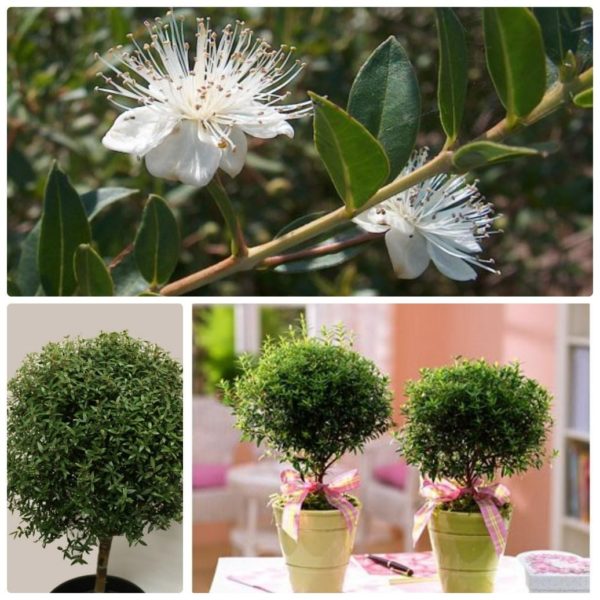
It is believed that the center of the spread of culture is in the Mediterranean, North Africa and the Azores. Now myrtles grow in nature in addition to the indicated regions in South-Western Europe, Florida (USA), South England, West Africa, Asia Minor and South Asia, in the Caribbean. Small landings can be found on the South Coast, the Black Sea coast of the Caucasus, the Absheron Peninsula.
Comment! The spread of the culture is restrained by two factors: increased requirements for moisture and low frost resistance. Even with a short-term drop in temperature to -9 ° C, the plant freezes strongly and may die.
The genus Myrtle includes evergreen trees and shrubs growing at an average speed, reaching a height of 1.5-5 m, with a width of 1-3 m. Dense branches form a compact crown. Shoots, depending on the species, can be tetrahedral or round, glabrous or slightly pubescent.

Blooming myrtle tree
Leaves are opposite, simple, with a solid edge, pronounced central vein, pointed tip and base, located on short petioles. Their shape is ovate-lanceolate, the texture is dense, leathery in some species, the length is from 2 to 5 cm and the width is 1-2.5 cm. The upper part of the leaves is dark green, glossy, the lower one is salad.
Interesting! Myrtle is a pretty plastic culture. It is noteworthy that even in plants obtained from cuttings of the same tree, the rate of development and the size of the leaves may differ.
Despite the dense texture, myrtle leaves are very delicate. When lightly rubbed with your fingers, aromatic oils with a pleasant characteristic scent are released. Essential glands are located throughout the leaf and are clearly visible when brought up to the light.
All types of myrtle bloom for a long time and profusely, for about 2 months in spring and summer, new buds constantly appear on the tree or shrub. They are located singly or collected in short tassels, have a simple but refined shape: numerous stamens with large anthers rise above the round calyx. Flowers up to 2 cm in diameter are fragrant, pollinated by bees. Their color depends on the species, it can be cream, pink, white or yellow.
By the end of summer, oval or spherical berries are tied.After ripening, they turn dark blue, purple, rarely white. Myrtle fruits can be eaten, but they are not tasty.

Flowers and fruits of myrtle
Reproduction of myrtle
You can propagate myrtle using cuttings or seeds. The first method is preferable, because when propagated by seeds, a new plant may lose varietal characteristics.
Propagation by cuttings
Either in July or in January-February, you need to select several young cuttings, the length of which does not exceed 6-9 centimeters. They should be carefully cut, remove the lower leaves. Treat the cut sites with any root growth stimulant. Plant the cuttings in a container, moisten the soil, remove to a dark place. After a month, young plants can be planted in separate pots.
Growing from seeds
For propagation of myrtle by means of seeds, a mixture of peat and sand is suitable - both components must be taken in equal quantities. Pour the soil into a shallow container, treat with a fungicide solution, and then spread the seeds over the surface. Sprinkle on top with a thin layer of the same mixture, cover with foil or glass.
It is important to water and ventilate crops as needed. The first shoots will appear in 7-14 days
When two true leaves are formed on them, they can be seated in separate pots.
How to transplant myrtle correctly

The composition of a high-quality nutrient soil mixture for myrtle should include the following components: 2 parts of humus, 1 part of vermiculite and a little vermiculite or other baking powder.
For easier removal of the plant from the flower container, it is recommended to stop watering 1-2 days before the procedure. The dried substrate will decrease in volume and the flower will easily be pulled out of the pot if you hold it by the lower part of the trunk. If the transplant is carried out due to the growth of roots, then this method may not work.
Then it is better to use a flat, thin object (for example, a metal ruler, a table knife with a rounded end, or something similar) and try to carefully separate the soil from the walls of the container, passing it along the inner walls
Drainage is poured into a new pot, then the prepared substrate and the plant is placed so that the root collar remains on the surface. Immediately, abundant watering is carried out, after which the water that has seeped into the flower tray after a while must be drained. The soil surface in the plant pot should be covered with a small layer of coconut fiber or vermiculite.
When transplanting due to the appearance of pests or diseases, the roots of the plant must be thoroughly rinsed and all damaged parts removed. Old soil should not remain on the plant, because harmful substances or small larvae of harmful insects may remain in it, which, after transplantation, will again harm the flower. Since this procedure is a real stress for the myrtle, you should not aggravate its condition by applying top dressing and abundant watering. It is best to transplant the plant into moist soil and leave it for a few days to adapt in a new location.
When forming and growing a mini-tree (bonsai) during transplantation, the excess part of the root system is pruned, but not more than 30%. Its size should correspond to the size of the crown of the "tree".
At the end of the procedure, the container with myrtle should be placed in a cool, shaded room.
How to care for myrtle at home
A home myrtle tree, like any indoor plants, will respond favorably to a loving attitude towards itself, first of all, it concerns watering and maintaining a minimum humidity.
Watering
What kind of care does home myrtle prefer?
Myrtle takes ordinary care very favorably, the same applies to watering. It should be constant from the beginning of spring days to the cold of autumn and moderately abundant, even in winter, during dormancy, when the plant will accumulate strength for a new impetus to growth, watering is slightly reduced, but in no way stopped.Everything should be maintained in a certain regularity, it should not be allowed to dry out near the near-trunk clod of earth. In winter, let the soil dry out a little, if you still skip watering, then you can use the method of immersing the flower in water with a pot, but make sure that excess liquid does not stagnate, be sure to drain.
Humidity
Moisture is not as vital for myrtle as timely watering, but one cannot completely disregard it. Therefore, in the summer, spraying the leaves and air around the myrtle is encouraged, especially in dry and hot summers. In winter, this method cannot be used categorically, since the temperature of the content is low. Water for spraying, however, as well as for irrigation, take soft, settled and room temperature.
Common myrtle transplant
In general, the transplantation of the myrtle tree is frequent, absolutely necessary. Adults are advised to live in one pot for up to five years. It should be carried out in winter or very early spring, when the tree is still at a dormant stage and nothing can be particularly damaged.
Before the procedure, the earthen lump should be slightly dried to make it easier to separate from the walls of the pot; remove the tree by carefully holding the trunk with your hand. If it is difficult to pull out, you can hold it along the wall with some blunt object
To ensure better survival, you can treat the roots with a growth stimulant. At the bottom, there must be a layer of drainage material ¼ part of the pot, then part of the soil on which to spread the roots and on top of the rest of the soil, slightly leveling it. Take the substrate at the rate of 2: 1 leaf earth and vermicompost, you can add vermiculite. After watering, carry out until the water begins to pour out from the bottom. Then the transplanted myrtle is taken out into a slightly darkened room, until it is completely engrafted.
But, there are several exceptions when it is urgently necessary to carry out this simple procedure:
We transplant the myrtle tree after purchase
It is imperative to transplant myrtle after purchase, but only carefully transferring it from the pot so as not to damage the roots, but at the same time untangling them. This must be done because the soil in stores is often not intended for a long stay of plants in them, is overflowing with various fertilizers and quite often harmful insects grow in it.
A transplant is also required for young individuals when they are actively growing and urgently need to change the pot, increasing its size by 2-3 cm
Immediately a very large pot, so to speak for growth, does not need to be taken, the plant will grow only at the root, and the trunk will remain weak, so everything should be in moderation. For a similar reason, that is, the pot has become just small, a transplant is also being made.
Another reason for replanting myrtle will be root rotting or damage to it by any pests. Then you should completely replace the entire earth, no longer transferring it with a clod of earth, but completely clearing the roots from the old earth, and from damaged or diseased parts. This method of transplanting is less reliable than transshipment, but otherwise, the myrtle tree may die altogether.
Myrtle photo











































We also recommend viewing:
- Cyclamen
- Gerbera home
- Ahimenez
- Mimosa flower
- Indoor hydrangea
- Papiopedilum
- Eucharis
- Azalea
- Fuchsia
- Poinsettia
- Streptocarpus
- Pentas
- Indoor geranium
- Begonia Elatior
- Crossandra
- Spathiphyllum
- Saintpaulia
- Coleria
- Gloriosa
- Pachistachis
- Indoor chrysanthemum
- Amaryllis
- Afelandra
- Kislitsa
- Abelia
- Ruellia
- Violets
- Abutilon
- Hippeastrum
- Tuberous begonia
- Pelargonium
- Indoor rose
- Gloxinia
- Medinilla
- Agapanthus
- Takka
- Hypocyrt
- Katarantus
- Anthurium
- Lantana
- Primula room
- Strelitzia
- Hatiora
- Passionflower
- Clivia
- Home begonia
- Brugmansia
- Hyacinth
HAMELATIUM - WAX MYRTH: LANDING AND CARE

chamelacium (wax myrtle) - photo
Once I saw a chamelacium plant at my friend's.
And literally fell in love with him.Please advise how to plant and grow it at home?
Inna Pavlovna KRUTOVERTOVA
There is a reason to fall in love with this plant. Chamelacium, or wax myrtle, undoubtedly attracts the eye with its evergreen decoration. And when flowers still appear on the tree, then plant 8 literally delights with its delicate beauty.
Characteristic
Wax myrtle is a rather low shrub that reaches a height of 0.5 m in the walls of the house. The leaves are narrow, needle-like, 2.5-4 cm in length, very reminiscent of needles. And in general, chamelacium is very similar to conifers, which purify and moisturize the air, which is very useful for those who are pestered by a dry cough. But myrtle is still different from conifers. He, like ordinary shrubs, sheds leaves, and then again pleases with green decoration.
Myrtle flowers are small - white or pink, very fragrant, they cover the plant abundantly from late February to mid-June.
Caring - heightened
Florists must be warned: this plant is quite difficult to grow at home. It is worth neglecting some of the rules - and you can say goodbye to your "ward", who will die.
Caring for myrtle begins with the fact that it is necessary to determine in advance where the pot with this plant, which is very fond of light, will stand. Moreover, the place should be such where there are no obstacles to the penetration of sunlight. And so that the myrtle does not lose its attractiveness, it is recommended to turn on a special phytolamp after sunset.
And when filling the pot with soil, it should be borne in mind that it must pass air and moisture well.
Reproduction
This plant is best planted in spring. If you decide to sow seeds, keep in mind that the probability of failure is very high, and there is a lot of hassle, and you will have to wait a very long time, so it is more efficient to plant a hame-lacium stalk. How to get it?
You need to carefully cut off the top of the branch and immediately put it in a jar of water, which should cover 1-2 cm of the cutting. Put the container in the brightest place and wait for the roots to appear. This can happen in 1.5 months. But a grower may have a problem: not all shoots will give roots. Therefore, it is recommended to cut several branches at once.
After the roots appear, you need to place the twig in the ground and cover with foil. You can immediately after cutting, place the cutting, treating it with a rooting stimulator, in a mixture of peat with sand. As soon as the seedling takes root, you can take care of it as for an ordinary plant, of course, after removing the shelter.
Care for myrtle is the same as for other indoor plants: watering, light, feeding. Water this culture as needed. The soil must remain moist and not dry out. They are fed with special fertilizers for myrtle, which are sold in flower shops. This is done once every 2-3 weeks. During the flowering period, the plant needs more nutrients, so the myrtle should be fed twice as often.
How to transplant?
Young plants are replanted every year. Adult specimens that grow in large floor pots are not touched, only once every couple of years they replace the topsoil five centimeters deep.
How to transplant myrtle correctly so as not to damage the root system? Take a pot, put a small layer of drainage on the bottom. You can use expanded clay, pebbles, crushed foam or brick chips. Drainage is necessary, as it will help prevent decay of the root system, preventing moisture stagnation. Water the soil in an old pot of myrtle so that it gets wet and makes it easier to pull the plant out of the pot. You can water the plant in advance, a few hours before transplanting, then you do not have to deal with too wet soil.
Gently remove the plant from the pot along with the earthy clod. Do not shake off the old soil, as this can damage the roots, which are very delicate and difficult to tolerate any intervention.Pour a small amount of prepared soil into a new pot, put an earthen ball there and fill the voids around the edges of the pot with new earth. As the space fills, compact the soil to avoid air voids. After planting, water the plant and store it in a dark place for a few days so that it can adapt to the new conditions.
Reproduction of myrtle
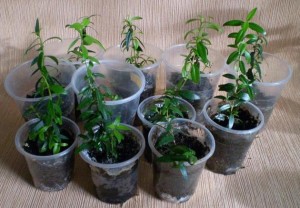
Myrtle can be propagated by cuttings and seedlings
To preserve maternal traits, the reproduction of myrtle is best carried out using cuttings. For this, it is necessary that the soil temperature is at least +25 ºC. It can be carried out in winter or in the middle of summer.
A cutting 7-9 cm long is cut from the lateral shoot of a healthy plant. A shorter cutting (5-7 cm) can also be used, but in this case it should be taken from the main, but not flowering shoot. At the same time, the lower leaves are removed, and the cut is processed with the help of "Kornevin".
Then the cuttings are planted in sandy peat soil and covered with foil or glass. The rooting process takes 2-3 weeks. After their expiration, the cuttings can be planted in separate pots.
Another way to reproduce myrtle at home is with seeds. True, this option has a significant drawback: varietal characteristics are unlikely to remain unchanged. In addition, the seeds germinate for a long time.
Sowing is carried out in early spring in a sandy-peat substrate, and sprinkled with soil on top. The container is covered with foil or glass sheet. For the success of the enterprise, it is necessary to provide diffused light in the room and a temperature of about +21 ºC. The first shoots will appear in 1-2 weeks. After the appearance of four leaves, young plants are seated in separate containers.
When growing myrtle from seeds, it is imperative to form a crown. To do this, pinch the sprout at a certain height.
How to properly grow Coleus from seeds.
Find out in detail about the diseases of the indoor flower of the hippeastrum.
REPRODUCTION OF MYRTH
When pruning in early spring, I leave the apical cuttings for propagation. I root both in water and in light soil. Young plants are very sensitive to changes in soil moisture, do not tolerate overflow and overdrying. Their root system is weak, and they may not cope with such stress and die.
Therefore, when watering, it is important to uniform and moderate soil moisture.
Myrtles grow quickly, the strongest bloom with rare flowers by autumn. I transplant young plants by transshipment, as soon as the pot becomes small, I do not immediately plant it in large containers. During transshipment, even in a flowering state, the plants do not get sick. Be sure to lay drainage on the bottom of the pots.
From observations of myrtle
The plant can overwinter at moderate room temperature. In this case, water it, as in the summer, is often sprayed and bathed in the shower once a week.
If myrtle hibernates in a cool place, it is better to postpone pruning until spring - more buds will wake up and the effect of pruning will be more noticeable. With a warm winter, the pruning time does not matter.
When transplanting, it is impossible to deepen the root collar, so as not to cause rotting of the trunk.
Frequent cutting of myrtle has a negative effect on flowering.
Myrtle tree home care
How to properly care for your home myrtle
Caring for myrtle at home involves following simple rules. Since it comes from warm regions, it is better to grow it on the southern windows, shading in the hottest hours. Of course, it can exist on the east and west windows, but it will feel less comfortable. You can also put it on the north window if there is no way out, but the flowers will not be so beautiful and plentiful. Myrtle is very fond of constant fresh air, therefore, it is not particularly afraid of drafts and moderate cold. Likes to stand on the balcony and on the kitchen window, which often opens.In the summer, of course, it is ideal to plant myrtle directly in the open ground, as if for hardening, at first slightly sheltering it from the strong sun and wind. It is necessary to get used to the change in temperature and lighting gradually. You can bury it in the ground directly with a pot so that no one can damage the root. See how your front garden looks spectacular with a myrtle tree on it.
The myrtle tree will always grow at home if you take care of it. The basic rule of caring for myrtle is to remember that in winter it has a period of rest, which you must provide for it. This should be done to strengthen the plant and ensure it is ready for the next flowering period, otherwise the myrtle tree may shed its leaves.
So, myrtus communis, how to care during the rest period?
- It must be placed in a room with a low temperature, it is quite cold-resistant and can withstand a drop of up to +5 degrees, but this is useless, just provide about +10 degrees.
- At the same time, the lighting should be bright enough, if there is not enough light, the dormant period will drag on for up to three months, and so do it twice as fast.
- An ideal place would be an insulated loggia or balcony facing the west side.
Growing myrtle as a bonsai tree
Often, the house plant myrtle flower is maintained in the form of a bonsai tree, that is, they take care of the trunk and leaves so that it looks lush and beautiful, without striving for the appearance of flowers. To do this, they use pruning of lateral branches, pinch fresh shoots and fertilize with nitrogen-containing additives for decorative deciduous plants. Such a pet will look unusual and rather exotic.
We do not particularly recommend getting carried away with this on young samples, since the trunk is not yet strong enough and has not gained power. Now, when the tree reaches 3-4 years old, then you can start trying. Then you get such an original tree.
Types and varieties
Common myrtle (Myrtus communis) or it is also called "communis" (aka "indoor") - the most common type in home gardening. This species is characterized by a short, well-branched trunk, which is covered with peeling reddish-brown bark.
The leaves are green, oval, shiny and have a pleasant aroma. The flowers are white (sometimes a slight pink tint is observed) with protruding stamens. Blooms in the summer season. The fruits are black berries with a reddish tint.
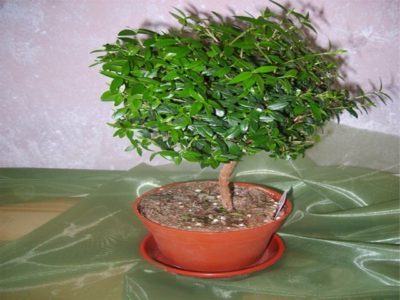
This type of myrtle has many varieties:
Myrtle Tarentina is a compact shrub with many fruits, smaller in size than that of the mother.

Variety myrtle Alhambra - has white berries and dense foliage.

Myrtle Variegata (Variegata) stands out among others with variegated foliage.

Myrtle "La Clape" - has purple berries.

Among them there is also a dwarf form - myrtle "Microphylla".
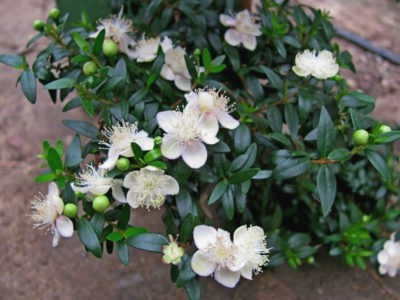
Myrtle Bonsai
This is a miniature copy of the tree, a very popular plant, is of great value among flower growers, its leaves contain essential oils used in medicine and cosmetology. The price of such a tree is not small.
The shape of such a tree can be varied, the trunk twists and bends in the process of growth, and thanks to periodic pruning of the shoots, you can form the shape of the crown at will.

Lush myrtle - it comes in the form of a bush, and in the form of a tree with brown peeling bark. Leaves are dull, dark green, white flowers blooming in July or August. The fruits are dark red - edible.

Myrtus chequen is a tree with glossy leaves and slightly wrinkled edges.
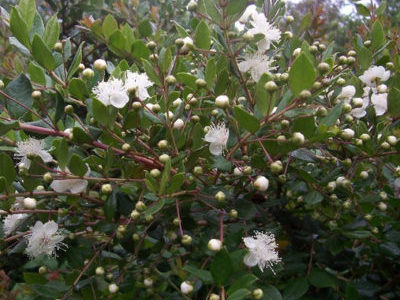
Ralph's myrtle (Myrtus ralfii) - this bush is distinguished by pink flowers and red edible berries. The leaves have a white or cream edging.

Myrtle Boetica
Large-leaved species, the leaves are larger than other species (6-7 cm, while the standard is 1-2 cm), with a pointed end. This myrtle grows very slowly. The trunk has an interesting feature - it twists, interesting shapes are formed in the process of growth.The flowers are white and large, and the berries are oblong, black.

Myrtle Hamedafna (Kassandra or marsh myrtle) is an evergreen shrub that grows exclusively in swamps, from which it got its name. It reaches a height of one meter. Young shoots and leaves contain poison that is dangerous to animals (goats and sheep).
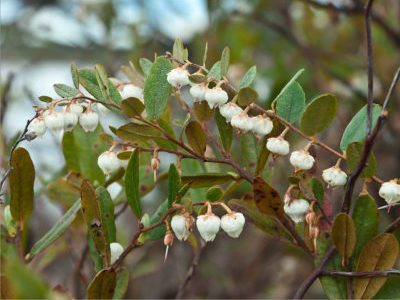
Lemon myrtle If you crush a leaf of such a plant, then you will feel a pronounced lemon aroma. In some countries, these leaves are used as a condiment. The size of the leaves: length 10 cm and width 1-4 cm. It blooms first with white flowers, and then darken to a creamy and slightly yellow hue.
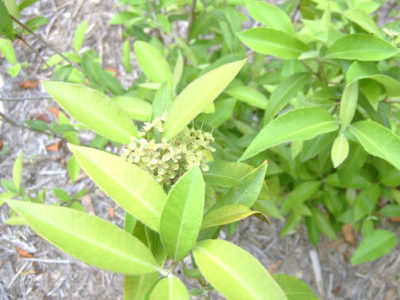
Possible difficulties in growing myrtle
If there is not enough light, the stems stretch out, the leaves shrink and turn pale, but in case of excess, they fade, turn yellow, the edges curl. In a dark room with a high temperature, the plant sheds its leaves.
The plant suffers greatly due to overdrying and overflow of the substrate. If the plant has dropped its leaves due to overdrying or waterlogging, the shoots should be cut in half and continue watering (in case of waterlogging, watering is very careful) and spraying. Young leaves may appear in two weeks.
If placed too warm and dark, leaves may fall off. If suddenly leaves began to fly around from the myrtle, then the matter is in improper watering: it is either insufficient or excessive. In this case, you can recommend immersing the overdried plant in water, and replanting the waterlogged plant. However, most often the plant cannot be saved.
Pests primarily affect old specimens. Too high air temperature in winter also contributes to this.
Bloom
Flowers usually appear in early summer and delight with their beauty for a couple of months. However, depending on the type of crop, flowering times may vary. The flowers are beautiful, painted in white or pinkish tones. On a tree, they are located either singly or with brushes. Petals are both regular and double. Flowering is accompanied by a wonderful aroma. The fruits of the culture are edible. They are usually blue or black, although there are other color variations.
In order for the tree to please every year with numerous spectacular flowers, it is necessary to remember some of the nuances. Do not prune the crop in the spring, it is better to prune after flowering.
It is also important to regularly ventilate the room so that the myrtle receives a portion of fresh air.

Possible problems
Myrtle in natural conditions has few pests and rarely gets sick. In pot culture, greenhouses and conservatories, despite the fact that it is an essential oil plant, it is annoyed by:
- whitefly;
- mealybug;
- spider mite;
- thrips;
- aphids.
Among the diseases, one should single out the mob (sooty fungus) and a variety of rot that can occur from excessive watering, especially in a poorly drained substrate.
Most problems can be dealt with by placing the wood in the bathroom and treating it with laundry soap. But you need to rinse the myrtle right away, while most other plants should stand for 15-30 minutes. If it stays in the soapy foam for more than 5 minutes, the alkali will simply burn the leaves, and they will fall off. The same will happen if at least a little soap remains on the plant.
Important! It is also necessary to rinse the myrtle after using chemical remedies.
Most of the other problems are related to landing and grooming errors:
- when the root collar is deepened, the myrtle will be very sore, wither away, and if urgent measures are not taken, it will die;
- if the leaves curl or turn black, the tree should be moved away from the light source or sprayed more often;
- myrtle can shed leaves in a draft, from overflow or drying out of the substrate, insufficiently sunny position; high temperature during rest, dry air;
- lack of light leads to the development of long, weak shoots on the tree, lack of flowering, the appearance of too small pale leaves.
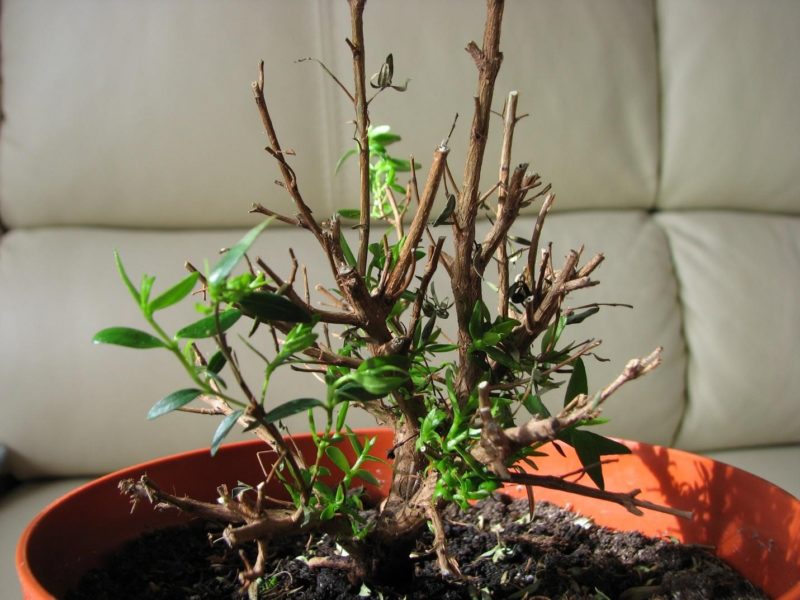
Sick tree

